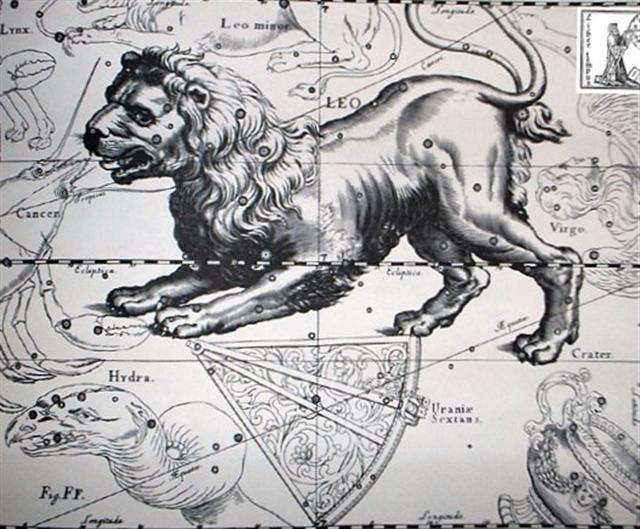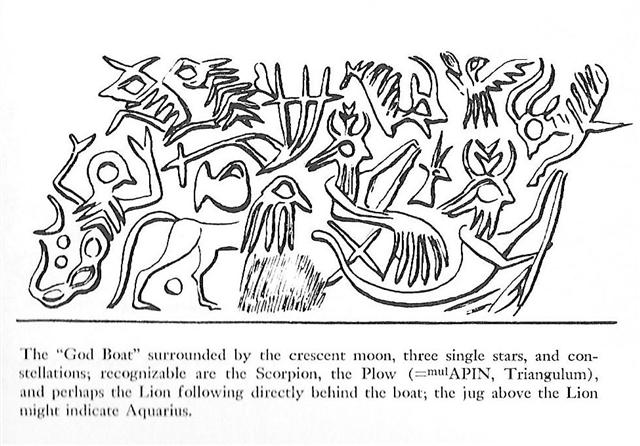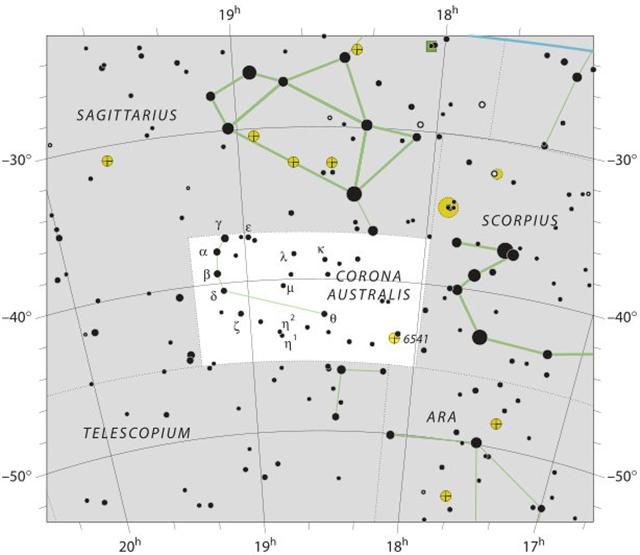You can measure a circle beginning anywhere and therefore
it was necessary to clearly mark from where to begin the counting. A
knot would do.
... Among the
Nahyssan of S. Carolina time was measured and a rude chronology
arranged by means of strings of leather with knots of various
colour, like the Peruvian quipos. The Dakota use a circle
as the symbol of time, a smaller one for a year and a larger one
for a longer period: the circles are arranged in rows, thus: OOO
or O-O-O. The Pima of Arizona make use of a tally. The year-mark
is a deep notch across the stick ...
Pictures were then added in order to clarify the correspondences
between the ordinal numbers and the positions in the sky.
The picture of a Lion, for instance, could hardly refer to
somewhere out at Sea.
... This [σ
Sagittarii] has been identified with Nunki of the
Euphratean Tablet of the Thirty Stars, the Star of the
Proclamation of the Sea, this Sea being the quarter
occupied by Aquarius, Capricornus, Delphinus, Pisces, and Pisces
Australis. It is the same space in the sky that Aratos
designated as Water ...

Similarly, when they began to load the Royal Double Canoe it
ought to refer to a place with the Sea in front.
... Hotu's canoe sailed from Maori
to Te Pito O Te Kainga. It sailed on the second day of
September (hora nui) ... [E:74]
|
"Aug 27 (239) |
5 |
"Sept 2 (245) |
42 |
"Oct 15 (288) |
|
239 - 16 = 223 |
245 - 16 = 229 |
288 - 16 = 272 |
|
223 - 41 = 182 |
229 - 41 = 188 |
272 - 41 = 231 |
|
182 - 39 = *143 |
188 - 39 = *149 |
231 - 39 = *192 |
|
Aug 12 (223) |
Aug 17 (229) |
Sept 29 (272) |
|
JUNE 7 |
8 |
9 (*80) |
10 (161) |
11 |
12 |
|
... The month,
which takes its name from Juppiter the oak-god,
begins on June 10th and ends of July 7th. Midway
comes St. John's Day, June 24th, the day on which
the oak-king was sacrificially burned alive. The
Celtic year was divided into two halves with the
second half beginning in July, apparently after a
seven-day wake, or funeral feast, in the oak-king's
honour
... |
 |
 |
 |
 |
 |
 |
|
Ga3-19 |
Ga3-20 |
Ga3-21 (80) |
Ga3-22 (161 - 80) |
Ga3-23 |
Ga3-24 |
|
The Knot
(Ukdah) |
5 Imix 9 Kumk'u
Rishu A.-13 (Head of the Lion)
ψ Leonis (146.4),
RAS ELASET AUSTRALIS = ε Leonis
(146.6)
*105.0 = *146.4 - *41.4 |
VATHORZ
PRIOR = υ Carinae
(147.9) |
|
Star-25 (Horse) /
ANA-HEU-HEU-PO-5 (Pillar where debates were held)
ALPHARD
(The Horse) =
α
Hydrae
(142.3),
ω
Leonis (142.6),
τ¹
Hydrae (142.7) |
Al Tarf-7 (The End)
ψ
Velorum (143.3),
ALTERF
= λ Leonis,
τ²
Hydrae (143.4),
ξ
Leonis (143.5)
*102.0 = *143.4 - *41.4 |
A Hydrae
(144.1)
VEGA (α
Lyrae) |
Creation of our present world
UKDAH (Knot)
= ι Hydrae
(145.4), κ Hydrae (145.5),
SUB-RA
= ο Leonis
(145.8)
*104.0 = *145.4 - *41.4 (= *288 - *184) |
|
Itzam-Yeh
defeated |
28 May (148),
3149 BC |
|
1st 3-stone place |
21 May (141),
3114 BC |
|
Creation of our
present world |
13 August (225),
3114 BC |
|
Och ta chan (Hun-Nal-Ye 'entered
or became the sky') |
5 February (36),
3112 BC |
|
21 May, 3114 BC -
5 February, 3112 BC = 542 |
|
542 'happens to
be' the sum of 365 days and 6 *
29½ nights. |

|
|
Aug 10 |
11 |
12 |
13 (225) |
14 (*146) |
15 (227 → π) |
|
°Aug 6 |
7 |
8 (220) |
9 (*141) |
10 |
11 |
|
'July 14 |
15 |
16 |
17 (*118) |
18 |
19 (200) |
|
SIRIUS |
"July 1 |
2 |
3 (*104) |
4 (185) |
Te
Anakena 5 |
|
... Makoi
replied, 'In Hiva the land belongs to him - the land
here is mine, not his [tae oona]!'
They stayed (there longer). On
the fifth day of the month of July (Anakena),
they all got up, went downhill, went on, and reached
Hanga Te Pau. They took their provisions
with them, carrying them on their shoulders, went
on, and reached Te Pou. They made camp and
slept in Te Pou on the
tenth of the month of July (Anakena).
Then they all got up, carried their provision on
their shoulders, went straight ahead, and followed
the path of the dream soul of Hau Maka. They
came to Hua Reva and said, This is Hua
Reva A Hau Maka!...
[E:21-22] |

 |
|
CLOSE TO THE FULL
MOON: |
|
DEC 7 |
8 |
9 |
10 (*264) |
11 (345) |
12 |
|
Al Sa'd al Su'ud-22 (Luckiest of the Lucky) /
Emptiness-11 (Rat)
TSIN =
36 Capricorni
(325.2),
ALPHIRK (The Flock) =
β
Cephei
(325.7),
SADALSUD = β Aquarii,
ξ
Gruis (325.9) |
no star listed (326) |
CASTRA
= ε Capricorni
(327.2),
BUNDA
= ξ Aquarii
(327.5)
SIRIUS (α
Canis Majoris) |
Mahar sha hi-na Shahū-26 (Western One in the Tail of
the Goat)
NASHIRA
=
γ
Capricorni
(328.0),
ν
Oct. (328.3), AZELFAFAGE
=
π¹
Cygni,
κ
Capricorni (328.7) |
Arkat sha hi-na Shahū-27 (Eastern One in the Tail of
the Goat)
ENIF (The Nose)
=
ε
Pegasi,
ERAKIS
=
μ
Cephei
(329.2),
46 CAPRICORNI,
JIH (the Sun)
=
κ
Pegasi
(329.3),
ι
Piscis Austrini (329.4),
λ
Capricorni (329.6),
ν
Cephei (329.7),
DENEB ALGIEDI
=
δ
Capricorni
(329.8)
*288.0 = *329.4 - *41.4 |
θ
Piscis Austrini
(330.1), λ Octantis (330.7) |
|
Febr 9 (40) |
10 |
11 |
12 (408) |
13 (*329) |
All Hearts' Day |
|
°Febr 5 (36) |
6 |
7 |
8 (*324) |
9 |
10 (41) |
|
'Jan 13 (378) |
14 |
15 (*300) |
16 |
17 |
18 (383) |
|
"Dec 30 |
31 (*285) |
"Jan 1 (366) |
2 |
3 |
4 |
|
... On February 9
the Chorti Ah K'in, 'diviners', begin the
agricultural year. Both the 260-day cycle and the
solar year are used in setting dates for religious
and agricultural ceremonies, especially when those
rituals fall at the same time in both calendars. The
ceremony begins when the diviners go to a sacred
spring where they choose five stones with the proper
shape and color. These stones will mark the five
positions of the sacred cosmogram created by the
ritual. When the stones are brought back to the
ceremonial house, two diviners start the ritual by
placing the stones on a table in a careful pattern
that reproduces the schematic of the universe. At
the same time, helpers under the table replace last
year's diagram with the new one. They believe that
by placing the cosmic diagram under the base of God
at the center of the world they demonstrate that God
dominates the universe. The priests place the stones
in a very particular order. First the stone that
corresponds to the sun in the eastern, sunrise
position of summer solstice is set down; then the
stone corresponding to the western, sunset position
of the same solstice. This is followed by stones
representing the western, sunset position of the
winter solstice, then its eastern, sunrise position.
Together these four stones form a square. They sit
at the four corners of the square just as we saw in
the Creation story from the Classic period and in
the Popol Vuh. Finally, the center stone is placed
to form the ancient five-point sign modern
researchers called the quincunx ...
... These 5 stones brought up
from the sacred spring formed the pattern of
Tawantinsuyu - Land defined from its 4 coloured
corners together with a 5th such (its Head) in the
center standing up tall like a Tree (or a Tentpole):
 |
 |
 |
On Easter Island they had their seasons 'upside down' compared
to the normal view north of the equator. Therefore they probably consulted
such
stars which could be seen to culminate around 21h in August 12.
... Allen has documented all his star
culminations at 21h, which could be due to an effort of keeping
the culminations at their proper places according to the
ancients, 24h (spring equinox) - 21h = 3h = 24h / 8 = 45º. 3h
corresponds to 366 / 8 = 45.75 of my right ascension days and
*366 - *46 = *320 (Dramasa, σ
Octantis) ...
Although Vega was too far in the north for observation
they could see Alphekka Meridiana (α
Corona Australis), which was at the Sun in January 5 and
culminated in the night after Vega:
|
ALPHEKKA MERIDIANA |
|
Jan 5 |
219 |
Aug 13 |
145
|
|
370 |
590 (225) |
|
*290 |
*510 (*145) |
|
145 + 221 = 366 |

From Nunki (the Star of the
Proclamation of the Sea) to Alphekka Meridiana
there were only *290 - *288 = 2 days - which hardly could be guessed from the
star map above.
... Eridhu, or Eri-duga, the Holy City, Nunki, or Nunpe, one
of the oldest cities in the world, even in ancient Babylonia, was that kingdom's
flourishing port on the Persian Gulf, but, by the encroachment of the delta, its
site is now one hundred miles inland. In its vicinity the Babylonians located
their sacred Tree of Life ...

|











